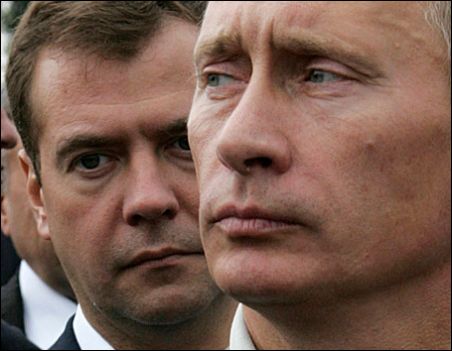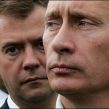
A Return of Putin to the Kremlin to Save the Nation?
Publication: Eurasia Daily Monitor Volume: 5 Issue: 218
By:

President Dmitry Medvedev’s address to the Federal Assembly had two principal political surprises, one internal and one external. Medvedev announced that the present Russian constitution, adapted by referendum in December 1993, would be amended to increase the term of office of president from four to six years and the parliamentary term from four to five years (www.kremlin.ru, November 5). Commentators in Moscow immediately concluded that these changes were designed to give former president and present Prime Minister Vladimir Putin (56) a new extended reign of 12 more years in the Kremlin as president. Kremlin insiders were quoted as saying that the appointment of Medvedev as president was specifically organized for him to arrange a change in the constitution and then to resign. The moment Medvedev resigns, Putin as prime minister becomes acting president. New elections must be held within three months, and there is no doubt that Putin will be reelected. It was reported that Kremlin insider Vladislav Surkov masterminded this plan in 2007 (Vedomosti; www.newsru.com, November 6).
After Medvedev’s surprise announcement, events began to evolve rapidly. This week the draft constitutional amendments were presented to the Duma (Interfax, November 11), and Putin publicly announced that he fully supported the move (Interfax, November 12). To change the constitution the amendments need a two-thirds majority in the Duma, three-fourths in the upper house (the Federation Council), and two-thirds ratification by the regional legislatures of the Russian Federation. The ruling United Russia party, which Putin leads, has full control of all the regional legislatures and has constitutional majorities in both houses of parliament. Leading Duma deputies have announced that the draft will be rushed through and the constitution changed, perhaps before the end of the year (Kommersant, November 12).
The return of Putin to the Kremlin may take place within a month or two after the amendments are adopted, ending the present masquerade in which the true ruler of Russia (Putin) pretends to be number two, while Medvedev imitates number one. Putin’s return to the Kremlin could consolidate the Russian bureaucracy and ruling elite, since it will remove all doubts about who is boss. Western leaders would surely favor the enhanced clarity provided by knowing who the ultimate decision-maker in Moscow is. This would enable them to target more effectively to whom they should talk to make things happen and to clinch agreements that will not be suddenly overruled by Russian diplomats or generals. The coming change will be genuinely welcomed by columnists worldwide, who today cannot easily use the traditional line "in the Kremlin" to describe Russian politics, since the true decision-maker Putin, as prime minister, does not reside there.
The reelection of Putin for six more years, if it indeed happens next year, will be in the midst of a financial and economic crisis in Russia that may cause social unrest. In a democratic nation the ruling party could easily lose such a snap election, but not in an increasingly totalitarian Russia, where the media is fully controlled and election results shamelessly rigged. Many ordinary Russians could, in fact, genuinely vote Putin back into the Kremlin as a national savior, one who led Russia out of the gloom of its previous economic crisis at the end of the 1990s.
In an apparent attempt to add to the feeling of crisis, Medvedev filled his address with anti-American rhetoric and threatened to deploy new Iskander (SS-26) missiles in the Kaliningrad region and aim them at planned U.S. MD GBI interceptors in Poland and an MD radar station in the Czech Republic (see EDM, November 10). It was later reported that five army rocket brigades armed at present with shorter-range Tochka-U missiles would be rearmed with the SS-26 aimed "in the Western direction." It has been reported that the Iskanders may also be deployed in Belarus (RIA-Novosti, November 7, 12).
The Russian military boasts that the Iskander-M has a range of up to 500 km, is highly accurate, and cannot be shot down by any missile defenses (Kommersant, November 6). At present several SS-26 missiles are deployed in the North Caucasus and were used against targets in Georgia last August. The Dutch Foreign Ministry announced after an investigation that Dutch cameraman Stan Storimans and four other people were killed in Gori on August 12 by an Iskander SS-26 missile with a cluster warhead (RIA-Novosti, October 20). The Russian Foreign Ministry replied that the evidence gathered by the Dutch was inconclusive (www.mid.ru, October 23). Apparently, the Russian military was aiming at a Georgian military base near Gori but missed and hit a residential area.
The SS-26 does not seem to have lived up to expectations on accuracy, and even with a nuclear warhead it may not be able to guarantee the destruction of reinforced silo-based GBI interceptors in Poland. Moreover, the GBIs, if they are ever deployed in Poland, would be unlikely to threaten Russia anyway. The Kremlin’s threat to deploy Iskanders in "the Western direction" does not make much military sense either. It is clearly a political move to threaten European nations, create tension, and hopefully undermine their alliance with the United States–a traditional Russian strategy. Increased tension would also support the argument that at a time of internal and external crisis Putin must be back at the helm.




